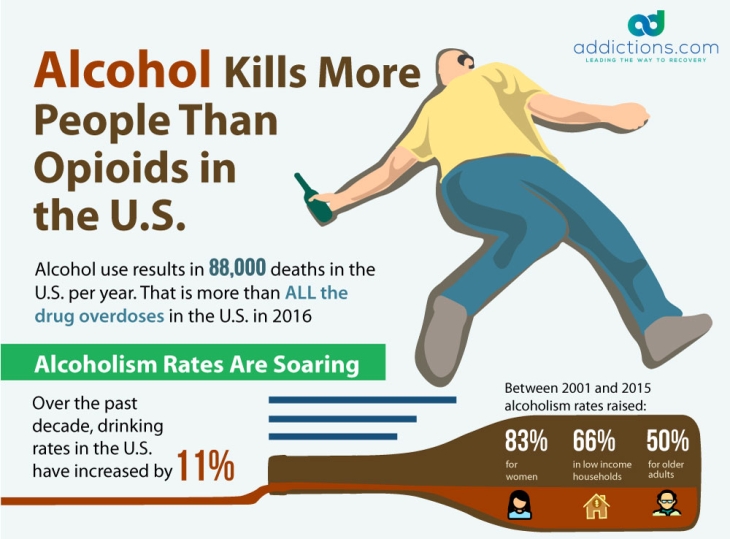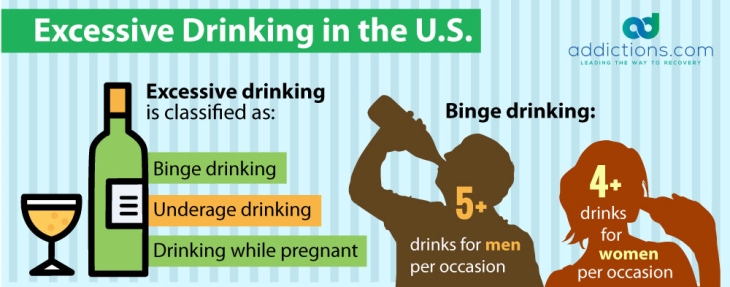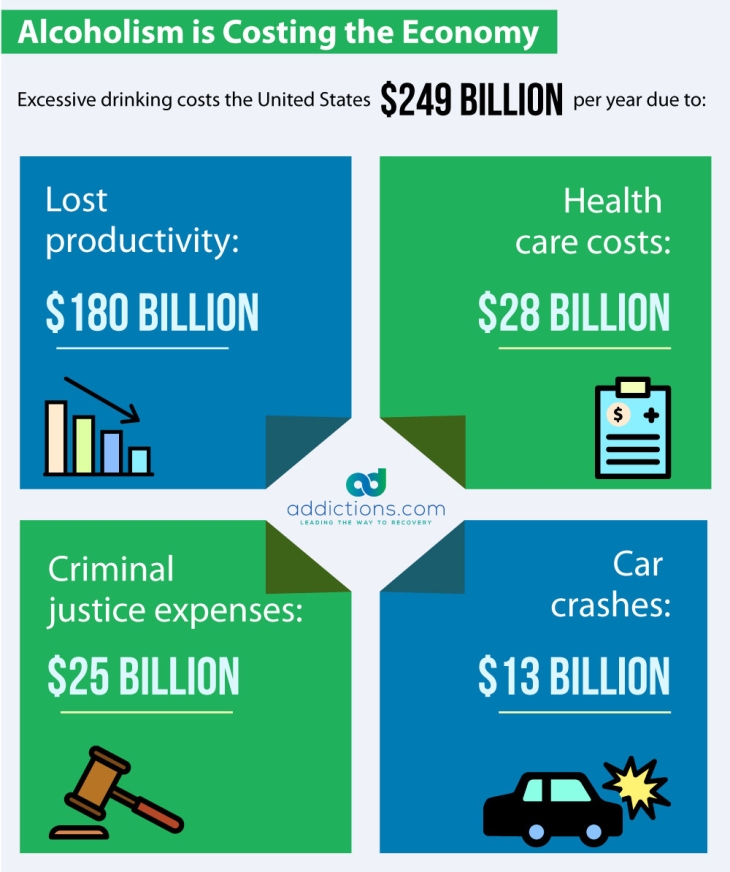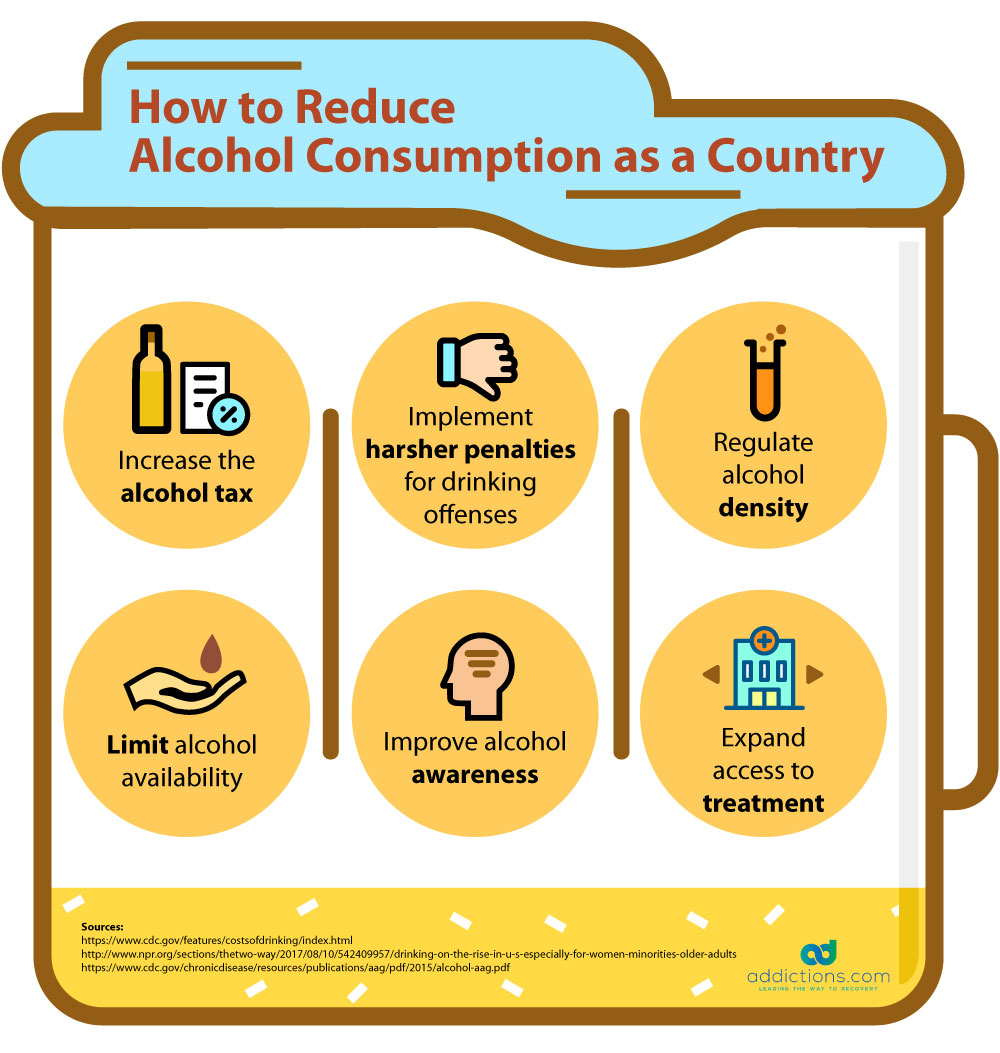Over 88,000 people die every year due to alcohol abuse, which is more than all opioid overdose fatalities put together. If the United States is facing an opioid addiction crisis, then there is no question we are also facing an alcohol addiction crisis.
Excessive alcohol use cost the United States 249 billion dollars in 2010. This cost comes from motor vehicle accidents caused by drinking (5%), criminal justice expenses (10%), the expense of treating medical problems or injuries related to excessive drinking (11%), and workplace productivity losses (72%).
The cost of problem-drinking is high in monetary value, but even higher in the reduced quality of life and increased physical and emotional pain that results from the short and long-term effects of alcohol. Unfortunately, rates of alcohol abuse are on the rise in the U.S. We need to figure out how to move past the excuses and find ways to turn the tide on excessive drinking to build a healthier nation.

What is considered excessive drinking?
Standards for excessive drinking are different between men and women due to the unique ways their bodies process alcohol. Men have a higher percentage of water in their bodies and a lower percentage of fat. This means that women can drink the same amount of alcohol as men of their same size and weight, but end up with a higher concentration of alcohol in the blood. This causes women to become intoxicated more quickly than men. Additionally, a woman’s stomach lining produces less alcohol dehydrogenase, an enzyme that breaks down alcohol in the stomach before it can enter the bloodstream.
Seventy-seven percent of the 249 billion dollars lost to alcohol misuse in 2010 was due to binge drinking, which is defined as five or more drinks in a single occasion for men, and four or more drinks in a single occasion for women. A drink is defined as 1.5 ounces of liquor or spirits (vodka, gin, whiskey, etc.), 5 ounces of wine, 8 ounces of malt liquor, or 12 ounces of beer.
Binge drinking is considered a form of “excessive drinking” — a term that also represents drinking by people under the age of 21 and any drinking by pregnant women. Heavy drinking is when a man consumes 15 or more drinks per week, or when a woman consumes 8 or more drinks per week. Not everyone who drinks excessively is an alcoholic, but excessive drinking does put them at a greater risk of developing an addiction.
Moderate drinking is defined as two drinks per day for men, and one drink per day for women. People who are recovering from alcohol addiction, who are pregnant or might be pregnant, who have certain medical conditions, who are taking OTC or prescription medications that interact with alcohol, or who are planning to drive or participate in activities that require alertness, coordination, and skill, are advised to not drink at all.

Alcoholism Statistics in the United States
Alcoholism statistics show that general drinking in the U.S. increased by 11% from 2002 to 2013, and high risk or binge drinking rose by nearly 30% overall. This increase was most dramatic among older adults, who experienced a 65% increase, and women, who experienced a 58% increase.
The U.S. also experienced dramatic increases in rates of alcohol abuse and alcohol dependence between 2002 and 2013, rising by almost 50% overall. Women, minorities, older adults, and the poor showed the highest increase in alcohol dependence and addiction. Rates of alcoholism and alcohol dependence increased by 83.7% among women, 92.8% among African-Americans, and by 65.9% among people earning less than $20,000 a year. Alcohol dependence more than doubled among older adults—a group that runs a much higher risk of disease, injury, and death from excessive drinking.
The increase in drinking among the female population may be due to changing attitudes towards women and alcohol, but could also be due to stress. There are still more male alcoholics than female, but the gender gap is rapidly narrowing. The fact that rates of problem drinking increased more among minorities may be due to the growing disparities of wealth, employment, housing, health, and education that these individuals face, which can lead to additional stress, depression, anxiety, and coping behaviors.
Alcoholism statistics also show that alcohol-related deaths rose from 20,000 a year to over 33,000 a year between 2001 and 2015. Also, more people are drinking today because alcohol has become very easy to access, and the cost has dropped considerably. In 1950, having one drink per day of the cheapest alcohol available would cost most people about 4.46% of their disposable income, while in 2011, the cost would only be 0.29%. An increase in socioeconomic problems and more prevalent mental health issues may also be playing a part as more and more Americans turn to alcohol to self-medicate. Only 10% of those who suffer from addictions like alcoholism actually receive treatment.

How can we reduce alcohol consumption as a society?
Here are some of the top recommended strategies for reducing alcohol consumption:
An Alcohol Tax: If the lowered cost of alcohol can induce an increased rate of drinking, then a higher cost of alcohol due to higher taxes at the state and federal levels should reduce drinking. Recent evidence has suggested that doubling the alcohol tax rate would reduce crime by 1.4%, alcohol-related violence by 2%, sexually transmitted diseases by 6%, motor vehicle accident fatalities by 11%, and alcohol-related mortality by 35%.
Harsher penalties for drinking offenses: There are many ways to penalize people for excessive drinking, including harsher DUI laws. South Dakota has seen success with its 24/7 Sobriety Program. Offenders who have had their drinking rights revoked after committing alcohol-related offenses are monitored through bracelets that track blood alcohol levels or twice-daily breathalyzer tests. Every failed test results in one or two days of jail time. The program has been linked to reductions in domestic violence arrests, DUIs, and alcohol-related death.
Harsher penalties for dram shop liabilities: Dram shop liability, or commercial host liability, is when retail establishments that sell alcohol are held liable for harms or injuries caused by over-serving intoxicated customers or serving underage customers.

Regulation of alcohol density: Through zoning and licensing regulations, the government could limit the number of alcoholic beverage outlets allowed to operate in any given area. Studies show that fewer alcohol outlets in an area does reduce excessive drinking and the associated dangers, except for alcohol-related car accidents, for which the evidence was mixed. Having people take longer drives to purchase alcohol could increase motor vehicle accidents if the consumers drink before returning home.
Limiting the amount of time available to purchase alcohol: Some communities and states already limit alcohol sales to certain times of day and certain days of the week. While the legal closing time for bars may be midnight in some areas, others allow alcohol to be served until 5 a.m. Studies on areas that have removed or reduced restrictions on alcohol sales show an increase in alcohol-related injuries and assaults, an increase in motor vehicle crashes and DUIs, and an increase in emergency room admissions. Some state and local laws prohibit the selling of alcohol on Sundays. When these laws were repealed, those areas saw a significant increase in alcohol-related fatalities.
Improved Alcohol Awareness: Our society has normalized harmful drinking behaviors such as binge drinking that can be dangerous in both the short and long term. Many people are not aware of these dangers, and also believe that a person cannot be addicted to alcohol if they are also able to hold down a job, pay their bills, maintain relationships, or otherwise present themselves as “together.” Understanding that there are high functioning alcoholics who can hide their addiction while secretly suffering for years can help people with alcohol use disorder and their loved ones better identify when professional help is needed.
Increased access to treatment for alcohol use disorder: Considering the wide treatment gap between individuals suffering from addiction to alcohol and how many of them receive specialty treatment, increasing access to treatment is a definite way to decrease rates of excessive drinking and the associated harms.
Short and Long Term Effects of Alcohol Consumption
It is important to understand the short and long-term effects of alcohol, especially for those who aren’t able to see how excessive drinking negatively impacts their quality of life.
Short-term effects of alcohol consumption, particularly binge drinking, can include:
- Decreased coordination, perception, vision, hearing, and judgment
- Breathing difficulties
- Headaches, stomach pain, vomiting, diarrhea
- Stillbirth, miscarriage, and fetal alcohol spectrum disorders
- High-risk sexual behaviors such as unprotected sex and sex with multiple partners, which can lead to sexually transmitted diseases and accidental pregnancy
- Illness or death due to alcohol poisoning from high blood alcohol levels
- Violent tendencies, including intimate partner violence, sexual assault, suicide and homicide
- Injuries such as burns, falls, drownings, and car accidents
- Memory lapses and blackouts
- Dizziness, fainting, unconsciousness
- Coma
Long-term effects of alcohol consumption include the development of serious problems, such as:
- Digestive problems, liver disease, gastritis, malnutrition, ulcers
- High blood pressure, stroke, heart disease
- Sexual problems
- Cancer of the colon, liver, esophagus, throat, mouth, and breast
- Social problems, including unemployment, family problems, and lost productivity and opportunity
- Learning and memory problems, including poor academic and professional performance and dementia
- Mental health issues such as anxiety and depression
- Brain and nerve damage
- Thiamine (Vitamin B1) deficiency, which can lead to a serious disorder characterized by disorientation, apathy, loss of coordination, and amnesia, and which can have fatal complications
The Emotional Toll of Alcoholism
Alcohol use disorder can disrupt a person’s life professionally and personally to cause problems with relationships, finances, as well as a host of psychological problems. General quality of life is reduced when someone is addicted to alcohol, no matter how “safely” they imbibe. Some who suffer from alcohol addiction may insist that they don’t have a drinking problem because they never drive while drunk, never misses work due to a hangover, and any other justification they can find. Insisting on these types of black-and-white guidelines only give the individual an excuse to keep drinking, which inarguably increases their risk of suffering the negative short and long-term effects of excess alcohol consumption.
It’s also important to remember that for many people, alcohol use disorder may have developed slowly, meaning that they gradually became acclimated to life while abusing alcohol. After receiving alcohol use disorder treatment, these individuals are pleasantly surprised to discover how much better they feel and how much happier they are while living a sober lifestyle. They had no idea how bad things were before because life as an alcoholic was “normal” for them.
Alcohol Use Disorder Treatment Options
Choosing to seek treatment for your alcohol use disorder will be the best decision you ever make. If you drink heavily or have been addicted to alcohol for a year or more, be sure to look after your physical and mental safety in the early days of your recovery by choosing a treatment facility that provides a medically monitored detox. Alcohol withdrawal can be highly dangerous for some and lead to a fatal form of withdrawal known as delirium tremens. This severe form of alcohol withdrawal can cause hallucinations, extreme agitation, and dangerous seizures. In these cases, it is crucial to seek professional medical attention to ensure your safety.
You will experience many phases to your alcohol addiction treatment, which may include inpatient or residential programs that have you living full-time at the treatment facility, outpatient programs that provide day or evening addiction treatment while you live at home, and aftercare services, which may include facility alumni events, relapse prevention counseling, and peer support groups.
